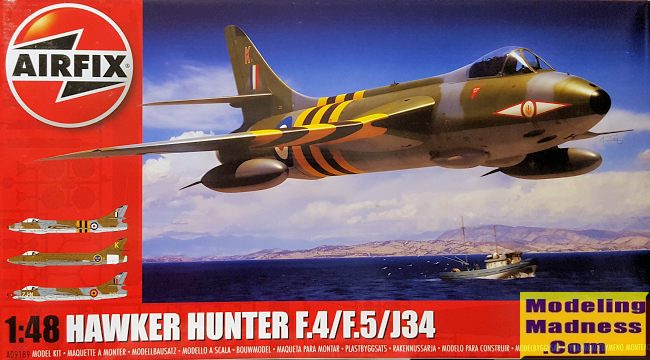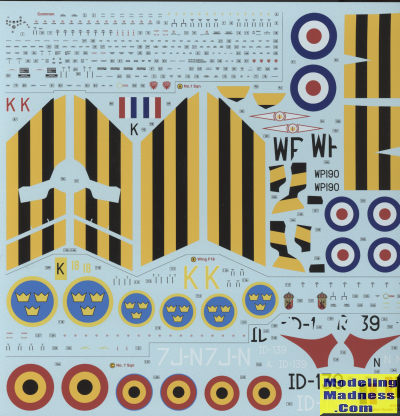
| KIT #: | A09189 |
| PRICE: | $42.39 |
| DECALS: | Three options |
| REVIEWER: | Scott Van Aken |
| NOTES: | 2020 release |

| HISTORY |
The single-seat Hunter was introduced to service in 1954 as a manoeuvrable day interceptor aircraft, quickly succeeding first-generation jet fighters in RAF service such as the Gloster Meteor and the de Havilland Venom. The all-weather/night fighter role was filled by the Gloster Javelin. Successively improved variants of the type were produced, adopting increasingly more capable engine models and expanding its fuel capacity amongst other modifications being implemented. Hunters were also used by two RAF display teams: the "Black Arrows", who on one occasion looped a record-breaking 22 Hunters in formation, and later the "Blue Diamonds", who flew 16 aircraft. The Hunter was also widely exported, serving with a total of 21 overseas air forces.
During the 1960s, following the introduction of the supersonic English Electric Lightning in the interceptor role, the Hunter transitioned to being operated as a fighter-bomber and for aerial reconnaissance missions, using dedicated variants for these purposes. Two-seat variants remained in use for training and secondary roles with the RAF and the Royal Navy until the early 1990s. Sixty years after its original introduction it was still in active service, being operated by the Lebanese Air Force until 2014.
The Hunter saw combat service in a range of conflicts with several operators, including the Suez Crisis, the Aden Emergency, the Sino-Indian War, the Indo-Pakistani War of 1965, the Indo-Pakistani War of 1971, the Rhodesian Bush War, the Second Congo War, the Six-Day War, the War of Attrition and the Yom Kippur War. Overall, 1,972 Hunters were manufactured by Hawker Aircraft and its successor, Hawker Siddeley, as well as being produced under licence overseas. In British service, the Hunter was replaced in its principal roles by the Lightning, the Hawker Siddeley Harrier and the McDonnell Douglas F-4 Phantom II.
| THE KIT |
This is the second release of the Hunter in 1/48 by Airfix. Previous to this Lindberg and Academy have produced 1/48 Hunteres. The Lindberg kit is probably nearly 50 years old while the newer Academy kit has its issues including a difficult to attach wing and a cockpit that is undersize. The F.6 version, with the toothed wing was released first and has sold quite well. This is the previous variant without the dog-tooth wing. There was no external difference between the Hunter F.4 and the F.5. The F.4 was powered by a Avon engine that was fraught with issues that were not cleared up satisfactorily until the F.6. The F.5 was powered by the Sapphire which had even more issues than the Avon so the number of F.5s built was rather small; about 100 airframes in total.
Typical of aircraft kits, construction starts in the cockpit. This is well appointed and Airfix provides the option of molded in harness or not. A decal is provided for the main instrument panel. Before the cockpit/gear well assembly is attached, one has to open the holes for the shell casing collectors.
One then goes on to attaching the rest of the nose gear well pieces, the first compressor stage and the intake assemblies. Before closing the fuselage halves, 20 grams has to be installed behind the cockpit to prevent tail sitting. Since Airfix will undoubtedly do an FGA.9, the exhaust section is separate so that is assembled and attached to the rear of the fuselage.
 We then get
to the wings. The kit supplies the dog-tooth wings so that part will have to be
removed from all wing pieces. Then one is to attach the upper wing halves. After building up the main gear wells, the lower sections are to be attached. If
you want to have drop tanks, be sure to open the holes for them. Then you can
build the new forward wing pieces and install those. Ailerons, flaps and rudder
are separate so you can pose those as you wish. The elevators are not and those
are then slotted in place. The next three pages of construction all deal with
installing the landing gear.
We then get
to the wings. The kit supplies the dog-tooth wings so that part will have to be
removed from all wing pieces. Then one is to attach the upper wing halves. After building up the main gear wells, the lower sections are to be attached. If
you want to have drop tanks, be sure to open the holes for them. Then you can
build the new forward wing pieces and install those. Ailerons, flaps and rudder
are separate so you can pose those as you wish. The elevators are not and those
are then slotted in place. The next three pages of construction all deal with
installing the landing gear.
Next the speed brake assembly is built. This can be posed lowered if you wish. The drop tanks and pylons are next, followed by the canopy, which can be open or closed as you wish. This finishes the build. As the F.4/5 was an interceptor, there is no outer wing pylon so no ordnance.
Instructions are very nicely done and typical for Airfix, only provide Humbrol paint numbers during the build. The large decal sheet provides markings for three airplanes. The box art plane is one of the F.5s with 1 Squadron during the Suez crisis of 1956. Another is a nice Belgian F.4 with 7 squadron in 1956. Finally a Swedish J.34 with 3 Squadron in 1959. This plane has white exercise markings. Full stencils are provided.
| CONCLUSIONS |
Recently the subject of a full build review, the builder found no real faults with the kit and said it builds fairly quickly. I have, of course, heard that before and what is a snap for others, is not always the piece of cake for me. The kit does have everything one would wish and is such that you'll need a few modeling skills when it comes to removing the wing leading edge to ensure a good fit for the replacement. That alone might send some to the F.6 kit where that is not necessary.
| REFERENCES |
https://en.wikipedia.org/wiki/Hawker_Hunter
August 2020
Copyright ModelingMadness.com. All rights reserved.
If you would like your product reviewed fairly and fairly quickly, please contact the editor or see other details in the Note to Contributors.
Back to the Main Page Back to the Review Index Page Back to the Previews Index Page